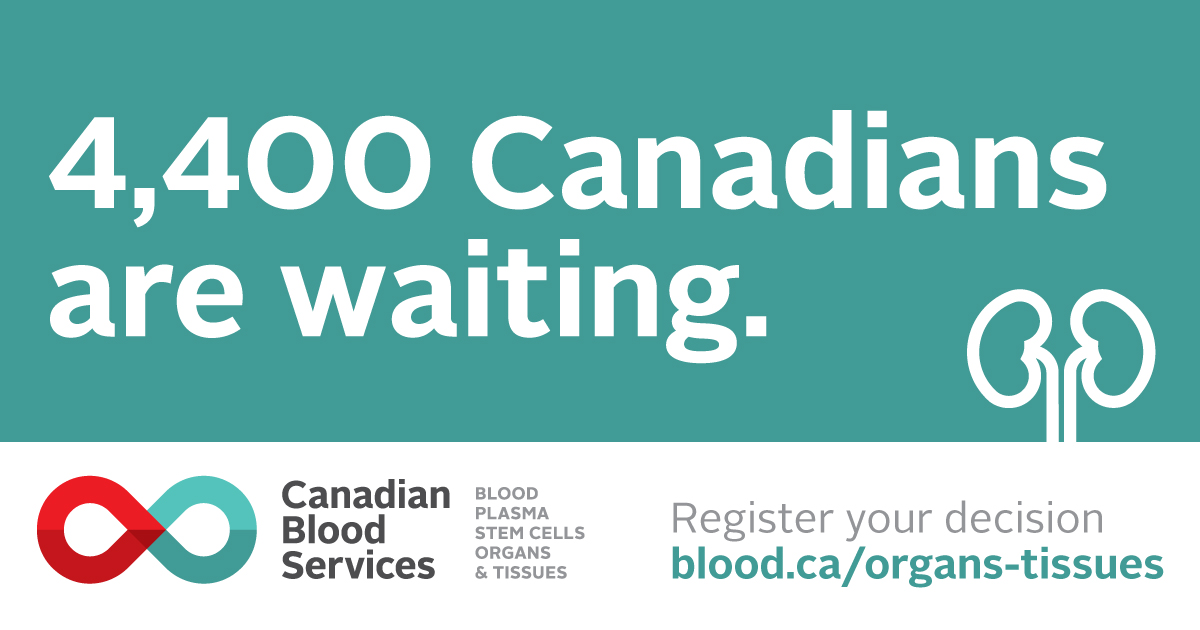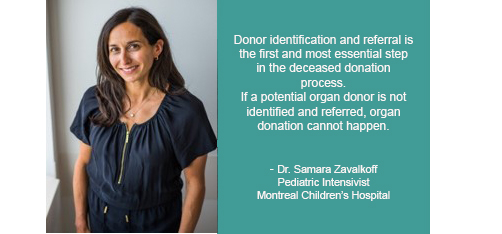Expert guidance seeks to improve identification of potential organ donors

Publication supports the critical care community in donor identification and referral allowing more potential organ donors to save more lives, and more donor families to be enabled to fulfill their loved one’s wishes
Just published in the Canadian Journal of Anesthesia: Potential organ donor identification and system accountability: expert guidance from a Canadian consensus conference
A Q&A with lead author Dr. Samara Zavalkoff
Deceased donation rates in Canada lag behind leading countries. A key area of focus to improve the system for all Canadians is to ensure health care professionals are able to identify and refer potential organ donors. If they are not equipped to identify and refer potential organ donors to organ donation organizations (ODOs) in a timely manner, patients on transplant waiting lists are left waiting and the wishes of potential donors and their families remain unfulfilled.
A Potential Organ Donor Identification and System Accountability (PODISA) Workshop was held September 20-21, 2016 in Ottawa. A collaboration between Canadian Blood Services and the Canadian Donation and Transplant Research Program (CDTRP), this workshop engaged representatives from critical care, neurocritical care, emergency medicine, donation, transplantation, research, health care administration, family partners, and patient safety and quality organizations. The results have now been published in the Canadian Journal of Anesthesia.
To better understand the importance of donor identification and referral, we spent some time with lead author Dr. Samara Zavalkoff a pediatric intensivist at Montreal Children’s Hospital.

Who are you and what do you do?
My name is Samara Zavalkoff and I am a pediatric intensive care physician at the Montreal Children’s Hospital. I look after children of all ages who are critically ill. I am an expert in patient safety and quality improvement. I have a keen interest in organ donation.
Can you tell us a bit about donor identification and referral?
Donor identification and referral is the process of recognizing when a patient who is gravely ill, dying or brain dead, has the potential to become a deceased organ donor and should be referred to an organ donation organization for follow up.
What are the issues that prevent potential donors from being identified as potential donors and referred to organ donation professionals?
Many reasons prevent identification and referral. They include:
- lack of proper education for health care professionals about how and when to identify potential donors,
- discomfort of healthcare professionals in discussing organ donation with family members,
- preconceived notions about what a family may want in terms of donation,
- limited access to resources to support identification and referral,
- little or no consequence when a potential organ donor is missed because many provinces do not have legislation that requires doctors to refer potential donors,
- lack of understanding about the impact a potential organ donor could have on a transplant candidate waiting for a life-saving organ, and
- circumstances whereby health care professionals become overburdened with other tasks and concerns when a patient reaches end-of-life.
Why is donor identification and referral so important?
Donor identification and referral is the first and most essential step in the deceased donation process. If a potential donor is not identified and referred, organ donation cannot happen. Failing to identify and refer a potential donor can have catastrophic consequences for transplant candidates awaiting an organ. A patient on the transplant list may die if a suitable donor is not found in time. Circumstances when a doctor does not identify and refer a potential organ donor, should be considered critical patient safety events.
Is it law that doctors in all provinces have to refer potential donors?
Today, referral of potential organ donors is law in only five provinces. Currently, British Columbia, Manitoba, Ontario, Quebec and Nova Scotia require that the provincial organ donation organization must be notified when death is imminent or established.
Would you consider this workshop a success?
Very much so. These guidelines are the result of a workshop hosted by Canadian Blood Services and the Canadian Donation and Transplant Research Program (CDTRP) that engaged representatives from critical care, neurocritical care, emergency medicine, donation, transplantation, research, health care administration, family partners, and patient safety and quality organizations. We gathered experts from areas across the organ donation community in Canada, including the very important perspectives of patients and donor families. They are the ones most impacted by donor identification and referral.
Ultimately, the meeting generated 37 expert consensus statements to establish best practices for healthcare professionals and the healthcare system with respect to donor identification and referral.
Why is collaboration among the healthcare community so important when it comes to potential donor identification and referral?
Donation opportunities are rare. Of 250 000 Canadians who die each year, only 2000-4000 will meet eligibility criteria for donation, and yet only 600 will become donors. In contrast, well over 4000 Canadians are waiting for an organ transplant.
This huge gap between actual donors and waiting recipients, the low-volume nature of organ donation and the high cost to patients if they do not receive a donated organ are the reasons that the healthcare system – and every professional working within it – must be highly coordinated in identification and referral of potential organ donors. Together, we must ensure that there are no missed opportunities in this complex process.
What are the outcomes from this collaboration?
Some of the key consensus statements developed as a result of the workshop are described as follows at both the professional and the system level.
At the healthcare professional level, key statements include:
- donation should be consistently addressed as part of end-of-life care but only after a decision to withdraw life-sustaining treatment;
- healthcare professionals should know how and when to identify and refer potential donors; and
- transplant candidates should be informed of local allocation guidelines and performance.
At the healthcare system level, key statements include:
- national adoption of clinical criteria to trigger identification and referral;
- dedicated resources to match donation activities, including transfer of a potential donor;
- performance measurement through death audits;
- reporting and investigation of missed donation opportunities;
- recognition of top performers; and
- missed donor identification and referral should be considered a preventable and critical patient safety incident
Why is it so important for Canadian patients that every potential donor is identified?
When we fail to identify and refer a donor, harm is caused to another patient who is awaiting an organ transplant. This harm is disconnected, as we don’t know the name or face of this patient on the transplant list, but it is a critical patient safety issue and an example of harm that should be prevented.
What is the impact on patients (donors and/or recipients) and their families?
Every Canadian who meets eligibility criteria has the right to be considered for organ donation. Every time a potential donor is not identified or referred, we deprive the patient and their family of fulfilling their wish to become a donor. For some families, organ donation is an important part of their grieving process and helps them attach meaning to their loved one’s death.
For transplant recipients, optimal compliance with donor identification and referral means the difference between life (receiving a transplant) and potentially death.
How can we make donor referral part of standard component of end-of-life care?
Making donor referral a part of end-of-life care falls into four key areas:
- The community needs proper data tracking in the form of donor audits across the country. We need to know the details (understand) of when and where and why donors are not being identified and referred. We need this data on an ongoing basis in real-time so the impact of interventions can be quickly measured.
- There is a need for education of healthcare professionals to know when and how to identify and refer potential donors.
- There is a need for legislation and policy to support compliance with donor identification and referral. For example, ALL provinces should have required referral legislation and an accreditation body that evaluates hospital performance in this area.
- It is essential that we advance the idea that failing to identify and refer a potential organ donor in a timely manner is a source of preventable patient harm and a public health concern. For every potential donor that is not identified and referred, a patient on the waitlist continues to wait.
In February Dr. Zavalkoff presented about this topic to the Donation Physician Network via webinar. A recording of that session can be found below. Additional webinars designed for Donation Physicians can be found on Canadian Blood Services' Professional Education website.
Further reading
- Find related resources on our Professional Education Website
- Read the full publication (open access): Potential organ donor identification and system accountability: expert guidance from a Canadian consensus conference
- Additional professional education resources can be found on Canadian Blood Services' Professional Education website.
- Also published in the April 2019 issue of Canadian Journal of Anesthesia/Journal canadien d'anesthésie
- Development of a national minimum data set to monitor deceased organ donation performance in Canada Karen Hornby BScN, MS, Sam D. Shemie MD…
- Engaging family partners in deceased organ donation research—a reflection on one team’s experience Amanda van Beinum MSc…
About the collaboration that enabled this expert guidance
Canadian Blood Services works with the Organ and Tissue Donation and Transplantation (OTDT) community to improve national system performance. We do this through the development of leading practices, professional education, public awareness and data analysis and reporting. We also manage clinical programs that support interprovincial sharing of organs.
The Potential Organ Donor Identification and System Accountability (PODISA) Workshop was held September 20-21, 2016 in Ottawa. It was an important collaboration between Canadian Blood Services and the Canadian Donation and Transplant Research Program (CDTRP). This workshop engaged Pan-Canadian representatives from critical care, neurocritical care, emergency medicine, donation, transplantation, research, health care administration, family partners, and patient safety and quality organizations. The results have now been published.
This important evidence-based leading practice:
- provides a national framework and consistent approach for donor identification and referral and system accountability,
- spearheads a culture shift around organ donation and end-of-life care, and
- unlocks potential opportunities for national collaboration, to support implementation, with patient safety and quality organizations.
The opinions reflected in this post are those of the author and do not necessarily reflect the opinions of Canadian Blood Services nor do they reflect the views of Health Canada or any other funding agency.